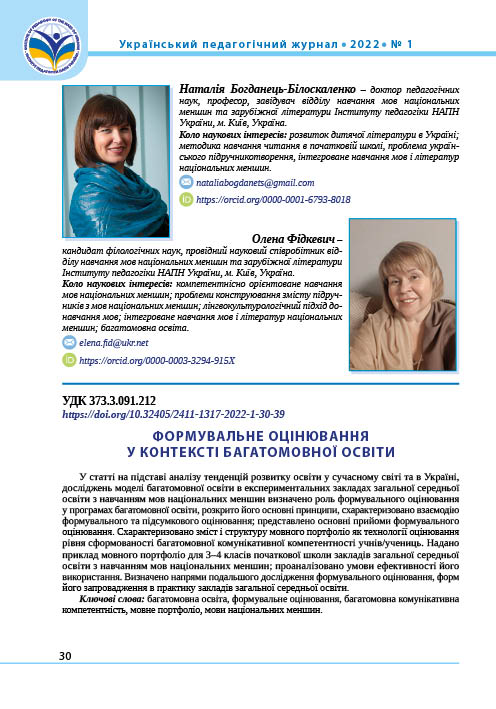Abstract
In the article, on the basis of the review of the tendencies of the development of modern education in the world and Ukraine, and the studies of the model of multilingual education in experimental general secondary education institutions with instruction in the languages of national minorities, the role of formative assessment in the programs for multilingual education is defined, its basic principles are considered, the interplay between formative and summative assessment are characterized; the major techniques of formative assessment are provided. In the process of formative evaluation, instead of detecting and documenting learning shortcomings, it is necessary to analyze the reasons that led thereto. Moreover, learner self-analysis is to precede teachers evaluation. The core feature of the formative assessment is that learning is viewed as involvement into everyday activities, while monitoring and evaluation procedures are regarded as a part of the process of acquisition of cognitive experience.
The content and structure of the language portfolio is a technology for evaluation the maturity level of multilingual competence of learners. The language portfolio provides an opportunity to define the level of learners skills, which demonstrate the formation of multilingual competence; learners motivation in learning languages and using them in everyday activities; learners reflection relating to their own academic achievements.
The example of the language portfolio for 3rd‑4th grades of the primary schools of general secondary education institutions with instruction in the languages of national minorities is provided; the context of the effective implementation thereof is analyzed. The trends of the further research of formative assessment and the forms of its implementation into the practice of teaching in general secondary education institutions are defined. Thus, an important challenge for pedagogical science is further comprehension of theoretical aspects of formative assessment in the context of reform of Ukrainian school, notably in the process of implementation of multilingual education and providing the respective scientific and methodological support at all stages of general secondary education in Ukraine.
References
Грищенко, М. (ред). (2016). Нова українська школа. Концептуальні засади реформування середньої освіти. https://mon.gov.ua/storage/app/media/zagalna%20serednya/nova-ukrainska-shkola-compressed.pdf
Закон України «Про освіту» (2017). https://zakon.rada.gov.ua/laws/show/2145–19#Text
Закон України «Про повну загальну середню освіту» (2020). https://urst.com.ua/act/pro_povnu_zagalnu_serednyu_osvitu
Державний стандарт початкової освіти (2018/2019). https: //zakon.rada.gov.ua/laws/show/87–2018-%D0%BF#n12
Державний стандарт базової основної освіти (2020). https://mon.gov.ua/ua/osvita/zagalna-serednya-osvita/nova-ukrayinska-shkola/derzhavnij-standart-bazovoyi-serednoyi-osviti
Scriven, M. (1967). The Methodology of Evaluation. In: Tyler, R., Gagné, R. and Scriven, M., Eds., Perspectives of Curriculum Evaluation (AERA Monograph Series on Curriculum Evaluation, No. 1), Rand McNally, Chicago, РР.39–83
Bloom, В. (1968). Learning for Mastery.UCLA Evaluation Comment 1 (2), 1968. Р.1–8.
Bloom, В., Hastings, J., Madaus, G. (1971). Hand book on formative and summative valuation of student learning. McGraw-Hill Companies. January 1.
Black, Р. Wiliam, D. (1998). Inside the Black Box: Raising Standards through Classroom Assessment. PhiDeltaKappan, Vol. 80, No. 2 (October), 1–12.
Локшина, О. (2009) Зміст шкільної освіти в країнах Європейського Союзу: теорія і практика (друга половина ХХ – початок ХХІ ст.). Київ.
Першукова, О. (2015). Розвиток багатомовної освіти школярів у країнах Західної Європи. Київ.
Берегова, О. та ін. (2020). Успішні практики багатомовної освіти в Україні. Київ.
Бібік, Н. (ред.). (2017). Нова українська школа: порадник для вчителя. Київ.
Фідкевич, О., Бакуліна, Н. (2019). Нова українська школа: теорія і практика формувального оцінювання у 1–2 класах закладів загальної середньої освіти. Київ.
Фідкевич, О., Богданець-Білоскаленко, Н. (2020а). Нова українська школа: теорія і практика формувального оцінювання у 3–4 класах закладів загальної середньої освіти. Київ.
Фідкевич, О., Богданець-Білоскаленко, Н. (2020b). Зміст і функції багатомовної комунікативної компетентності учнів закладів загальної середньої освіти України. Український педагогічний журнал. 3, 66–74.
Карпюк, О. (2008). Європейське мовне портфоліо: методичне видання. Тернопіль.
Hryshchenko, M. (red). (2016). Nova ukrainska shkola. Kontseptualni zasady reformuvannia serednoi osvity. https://mon.gov.ua/storage/app/media/zagalna%20serednya/nova-ukrainska-shkola-compressed.pdf (іn Ukrainian).
Zakon Ukrainy «Pro osvitu» (2017). https://zakon.rada.gov.ua/laws/show/2145–19#Text (іn Ukrainian).
Zakon Ukrainy «Pro povnu zahalnu seredniu osvitu» (2020). https://urst.com.ua/act/pro_povnu_zagalnu_serednyu_osvitu (іn Ukrainian).
Derzhavnyi standart pochatkovoi osvity (2018/2019). https: //zakon.rada.gov.ua/laws/show/87–2018-%D0%BF#n12 (іn Ukrainian).
Derzhavnyi standart bazovoi osnovnoi osvity (2020). https://mon.gov.ua/ua/osvita/zagalna-serednya-osvita/nova-ukrayinska-shkola/derzhavnij-standart-bazovoyi-serednoyi-osviti (іn Ukrainian).
Scriven, M. (1967). The Methodology of Evaluation. In: Tyler, R., Gagné, R. and Scriven, M., Eds., Perspectives of Curriculum Evaluation (AERA Monograph Series on Curriculum Evaluation, No. 1), Rand McNally, Chicago, RR.39–83. (іn English).
Bloom, V. (1968). Learning for Mastery.UCLA Evaluation Comment 1 (2), 1968. R.1–8. (іn English).
Bloom, V., Hastings, J., Madaus, G. (1971). Hand book on formative and summative valuation of student learning. McGraw-Hill Companies. January 1. (іn English).
Black, R. Wiliam, D. (1998). Inside the Black Box: Raising Standards through Classroom Assessment. PhiDeltaKappan, Vol. 80, No. 2 (October), 1–12. (іn English).
Lokshyna, O. (2009) Zmist shkilnoi osvity v krainakh Yevropeiskoho Soiuzu: teoriia i praktyka (druha polovyna KhKh – pochatok KhKhI st.). Kyiv. (іn Ukrainian).
Pershukova, O. (2015). Rozvytok bahatomovnoi osvity shkoliariv u krainakh Zakhidnoi Yevropy. Kyiv. (іn Ukrainian).
Berehova, O. ta in. (2020). Uspishni praktyky bahatomovnoi osvity v Ukraini. Kyiv. (іn Ukrainian).
Bibik, N. (red.). (2017). Nova ukrainska shkola: poradnyk dlia vchytelia. Kyiv. (іn Ukrainian).
Fidkevych, O., Bakulina, N. (2019). Nova ukrainska shkola: teoriia i praktyka formuvalnoho otsiniuvannia u 1–2 klasakh zakladiv zahalnoi serednoi osvity. Kyiv. (іn Ukrainian).
Fidkevych, O., Bohdanets-Biloskalenko, N. (2020a). Nova ukrainska shkola: teoriia i praktyka formuvalnoho otsiniuvannia u 3–4 klasakh zakladiv zahalnoi serednoi osvity. Kyiv. (іn Ukrainian).
Fidkevych, O., Bohdanets-Biloskalenko, N. (2020b). Zmist i funktsii bahatomovnoi komunikatyvnoi kompetentnosti uchniv zakladiv zahalnoi serednoi osvity Ukrainy. Ukrainskyi pedahohichnyi zhurnal. 3, 66–74. (іn Ukrainian).
Karpiuk, O. (2008). Yevropeiske movne portfolio: metodychne vydannia. Ternopil. (іn Ukrainian).

This work is licensed under a Creative Commons Attribution-NonCommercial-ShareAlike 4.0 International License.

